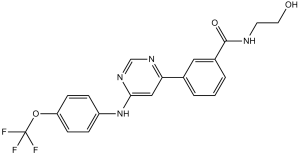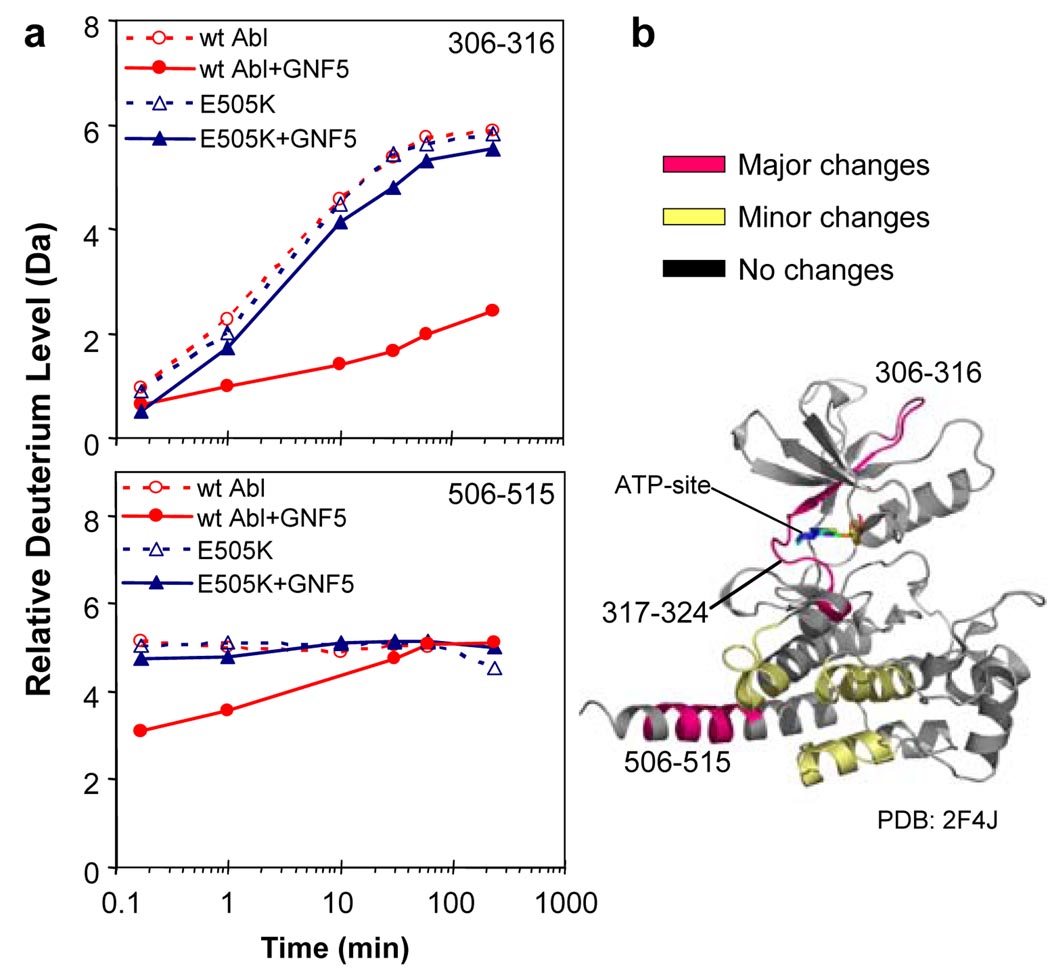This product is for research use only, not for human use. We do not sell to patients.

| Size | Price | Stock |
|---|---|---|
| 500mg | $620 | Check With Us |
| 1g | $980 | Check With Us |
| 5g | $2480 | Check With Us |
Cat #: V0674 CAS #: 778277-15-9 Purity ≥ 98%
Description: GNF-5 (GNF 5; GNF5), a GNF-2 analog with better pharmacokinetic profiles, is a potent, selective and allosteric/non-ATP competitive Bcr-Abl inhibitor with potential anticancer activity. It inhibits Bcr-Abl (wild-type Abl) with an IC50 of 220 nM. It exhibits excellent in vivo anticancer efficacy in Ba/F3.p210 xenograft mouse model.
References: [1]. Zhang J, et al. Targeting Bcr-Abl by combining allosteric with ATP-binding-site inhibitors. Nature. 2010 Jan 28;463(7280):501-6.
Publications Citing InvivoChem Products
Product Promise

- Physicochemical and Storage Information
- Protocol
- Related Biological Data
- Stock Solution Preparation
- Quality Control Documentation
| Molecular Weight (MW) | 418.37 |
|---|---|
| Molecular Formula | C20H17F3N4O3 |
| CAS No. | 778277-15-9 |
| Storage | -20℃ for 3 years in powder formr |
| -80℃ for 2 years in solvent | |
| Solubility In Vitro | DMSO: 83 mg/mL (198.4 mM)r |
| Water: <1 mg/mLr | |
| Ethanol: 20 mg/mL warmed (47.8 mM) | |
| SMILES Code | O=C(NCCO)C1=CC=CC(C2=NC=NC(NC3=CC=C(OC(F)(F)F)C=C3)=C2)=C1 |
| Synonyms | GNF 5; GNF5; GNF-5 |
| Protocol | In Vitro | In vitro activity: GNF-5, when used in combination with imatinib or nilotinib, suppresses the emergence of resistance mutations in vitro, and displays additive inhibitory activity in biochemical and cellular assays against Bcr-Abl T315I mutant. GNF-5 shows potent antiproliferative activity with EC50 of 430 nM and 580 nM against wt-Bcr-Abl and E255K mutant Bcr-Abl transformed cells, respectively. Kinase Assay: The ATP/NADH-coupled assay system in a 96-well format is used to determine the initial velocity of Abl tyrosine kinase catalyzed peptide phosphorylation. The reaction mixture contained 20 mM Tris-HCl, (pH 8.0), 50 mM NaCl, 10 mM MgCl2, 2 mM PEP [2-(Phosphonooxy)- 2-propenoic acid) and 20 μg Abl peptide substrate (EAIYAAPFAKKK), fixed or varied (to determine inhibitor kinetic parameters) concentration of inhibitor applied, 1/50 of the final reaction mixture volume of PK/LDH enzyme (pyruvate kinase/lactic dehydrogenase enzymes from rabbit muscle), 160 μM NADH, 0.16 μM Abl, and ATP added last to start the reaction. Absorbance data are collected every 20s at 340 nm using a SpectraMax M5 Microplate Reader. Cell Assay: Ba/F3.p210 cells are obtained by transfecting the IL-3-dependent murine hematopoietic Ba/F3 cell line with a pEYK vector containing p210BCR-ABL and Bcr-Abl mutations. All cell lines are cultured with 5% CO2 at 37 °C in RPMI 1640 with 10% fetal bovine serum (FBS) and supplemented with 1% l-glutamine. Parental Ba/F3 cells are similarly cultured with 10% WEHI-conditioned medium as a source of IL-3. Transfected cell lines are cultured in media supplemented with 25 μg/mL zeocin. The 48 h cell proliferation studies are obtained using the CellTiter-Glo assay. |
|---|---|---|
| In Vivo | GNF-5 (100 mg/kg ) displays efficacy on wild-type and T315I Bcr-Abl dependent proliferation in xenograft and bone marrow transplantation models. Moreover, a combination of GNF-5 (75 mg/kg) with nilotinib (50 mg/kg) results in improved overall survival in a T315I Bcr-Abl BMT model. | |
| Animal model | Ba/F3.p210 xenograft mouse model | |
| Formulation | Dissolved in PEG400/saline (1:1) | |
| Dosages | 100 mg/kg ; p.o. |
| Solvent volume to be added | Mass (the weight of a compound) | |||
|---|---|---|---|---|
| Mother liquor concentration | 1mg | 5mg | 10mg | 20mg |
| 1mM | 2.3902 mL | 11.9511 mL | 23.9023 mL | 47.8046 mL |
| 5mM | 0.4780 mL | 2.3902 mL | 4.7805 mL | 9.5609 mL |
| 10mM | 0.2390 mL | 1.1951 mL | 2.3902 mL | 4.7805 mL |
| 20mM | 0.1195 mL | 0.5976 mL | 1.1951 mL | 2.3902 mL |
This equation is commonly abbreviated as: C1 V1 = C2 V2
- (1) Please be sure that the solution is clear before the addition of next solvent. Dissolution methods like vortex, ultrasound or warming and heat may be used to aid dissolving.
- (2) Be sure to add the solvent(s) in order.







































